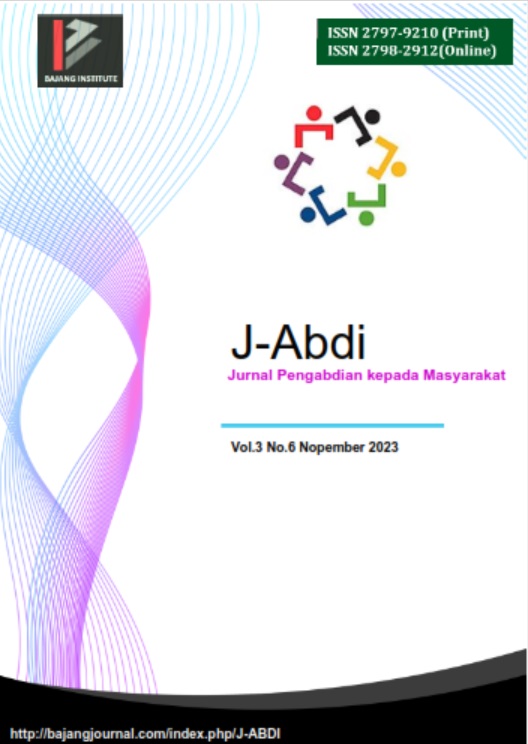PELATIHAN PENGEMBANGAN RPP UNTUK PJBL-STEM-ASESMEN FORMATIF BERORIENTASI LITERASI SAINS BAGI GURU IPA SMPN SE-KOTA MALANG
DOI:
https://doi.org/10.53625/jabdi.v3i6.6756Keywords:
PjBL, STEM, AF, Literasi SainsAbstract
Beberapa guru IPA SMPN se-Kota Malang masih sesekali saja melakukan pembelajaran dengan model yang berpusat pada siswa, misalnya pembelajaran kooperatif. Karena fakta bahwa IPA merupakan peristiwa/permasalahan sehari-hari, maka sangat sesuai bila dibelajarkan melalui model PjBL-STEM Dilengkapi Asesmen Formatif. Tujuan pengabdian ini adalah meningkatkan kualitas pembelajaran PjBL-STEM dengan asesmen formatif untuk memfasilitasi meningkatnya literasi sains siswa. Pengabdian ini dilakukan sebanyak 5 kali, yakni 6, 13, 20, dan 27 September, dan 4 Oktober 2023, dengan kegiatan berturut-turut memperkenalkan landasan teori terhadap pembelajaran PjBL-STEM-AF berorientasi literasi sains dan memberi contoh praktik pembelajarannya, mengembangkan desain RPP berbasis pembelajaran PjBL-STEM-AF berorientasi literasi sains, mempraktikkan RPP berbasis pembelajaran PBL-STEM-AF berorientasi literasi sains ke dalam kelas pembelajaran riil sebanyak 2 kali pertemuan, dan mengevaluasi dan merumuskan tindak lanjut dari praktik kelas pembelajaran PBL-STEM-AF berorientasi literasi sains. Pada akhir kegiatan pengabdian peserta mengisi angket respon melalui Google Form. Hasil pengabdian ini menunjukan bahwa kilas balik materi pelatihan peserta merasa paham terhadap PjBL-STEM-AF berorientasi literasi sains, peserta merasa mampu menyusun RPP PjBL-STEM-AF berorientasi Literasi Sains, dan peserta merasa mampu mempraktikkannya dalam pembelajaran riil di kelas, serta pembelajaran PBL-STEM-AF mampu menghasilkan literasi sains siswa yang baik
References
Beers, S. Z. 2011. What are the skills students will need in the 21 st century? London: ASCD Author.
Bybee, R., McCrae, B. & Laurie, R. 2009. PISA 2006 : An Assesment of Scientific Literacy. Journal of Research in Science Teaching, 46 (8): 865-883
Capraro, R. M., & Corlu, M. S. 2013. Changing Views On Assessment For Stem Project-Based Learning Introduction. STEM Project-Based Learning An Integrated Science, Technology, Engineering, And mathematics (STEM) Approach. (p. 109-98). Netherland: Sense Publisher
Feinstein, N. “Salvaging Science Literacy,” Sci. Educ., vol. 95, no. 1, pp. 168–185, 2011, doi: 10.1002/sce.20414.
Guthrie J T, Allan W and Clare V 2000 Effects of integrated instruction on motivation and strategy use in reading Journal of Educational Psychology 92 2 331–341
Harosid, H. Kurikulum 2013 revisi 2017. Diakses dari laman: https://dosen.ikipsiliwangi.ac.id/wp-content/uploads/sites/6/2018/09/GAMBARAN-UMUM-K13-REVISI-2017-1.pdf
Jauhariyyah, F. R., Hadi Suwono, & Ibrohim. 2017. Science , Technology , Engineering and Mathematics Project Based Learning ( STEM-PjBL ) pada Pembelajaran Sains. In Pros. Seminar Pend. IPA Pascasarjana UM (Vol. 2, pp. 432–436).
Khaira, N. 2018. Pengaruh Pembelajaran STEM Terhadap Peserta Didik pada Pembelajaran IPA. In Seminar Nasional MIPA IV (pp. 233–237).
M. Kertil and C. Gurel, “Mathematical Modeling: A Bridge to STEM Education,” Int. J. Educ. Math. Sci. Technol., vol. 4, no. 1, p. 44, 2016, doi: 10.18404/ijemst.95761.
Morgan, J. R., & Slough, S. W. 2013. Stem Project-Based Learning And Teaching For Exceptional Learners. STEM Project-Based Learning An Integrated Science, Technology, Engineering, And mathematics (STEM) Approach. (p. 85-98). Netherland: Sense Publisher
Narut, Y. F.and Supradi, K. “Literasi Sains Peserta Didik dalam Pembelajaran IPA di Indonesia,” J. Inov. Pendidik. Dasar, vol. 3, no. 1, pp. 61–69, 2019.
OECD, PISA 2015 Assessment and Analytical Framework: Science, Reading, Mathematic, Financial Literacy and Collaborative Problem Solving Revised Edition. Paris: OECD Publishing, 2017.
Parno, L Yuliati, I P Ndadari and M Ali. Project Based Learning Integrated STEM to Increase The Scientific Literacy in The Topic of Fluid Statics. doi: 10.1088/1742-6596/1491/1/012030 doi journal: 10.1088/issn.1742-6596 (Journal of Physics: Conference Series, Volume 1491 (2020) 012030 05 Juni 2020
Ramsey, B. S., & Duffy, A. 2016. Formative Assessment in the Classroom. USA: Education First
Reeve, E. M. (2015). Science, Technology, Engineering and Mathematics (STEM) education is here to stay
Song, Y. 2018. Improving primary students’ collaborative problem solving competency in project-based science learning with productive failure instructional design in a seamless learning environment. Educational Technology Research and Development, 66(4), 979–1008.
Stohlmann, M., Moore, T. J., & Roehrig, G. H. (2012). Considerations for teaching integrated STEM education. Journal of Pre-College Engineering Education Research (J-PEER), 2(1), 4
Suharto. Pedagogi: Model-model Pembelajaran IPA dan Implementasinya. P4TK IPA – Dirjen GTK – Kemdikbud – 2016
Tati T, Firman H and Riandi R 2017 The Effect of STEM Learning through the Project of Designing Boat Model toward Student STEM Literacy IOP Conf. Series: Journal of Physics: Conf. Series 895 (2017) 012157
Torlakson, T. 2014. INNOVATE: A Blueprint for Science, Technology, Engineering, and Mathematics in California Public Education. California. California Departement Of Education.
Tseng, K. H., Chang, C. C., Lou, S. J., & Chen, W. P. 2013. Attitudes towards science, technology, engineering and mathematics (STEM) in a project-based learning (PjBL) environment. International Journal of Technology and Design Education, 23(1), 87–102.
Wurdinger, S., & Qureshi, M. 2015. Enhancing College Students’ Life Skills through Project Based Learning. Innovative Higher Education, 40(3), 279–286.














